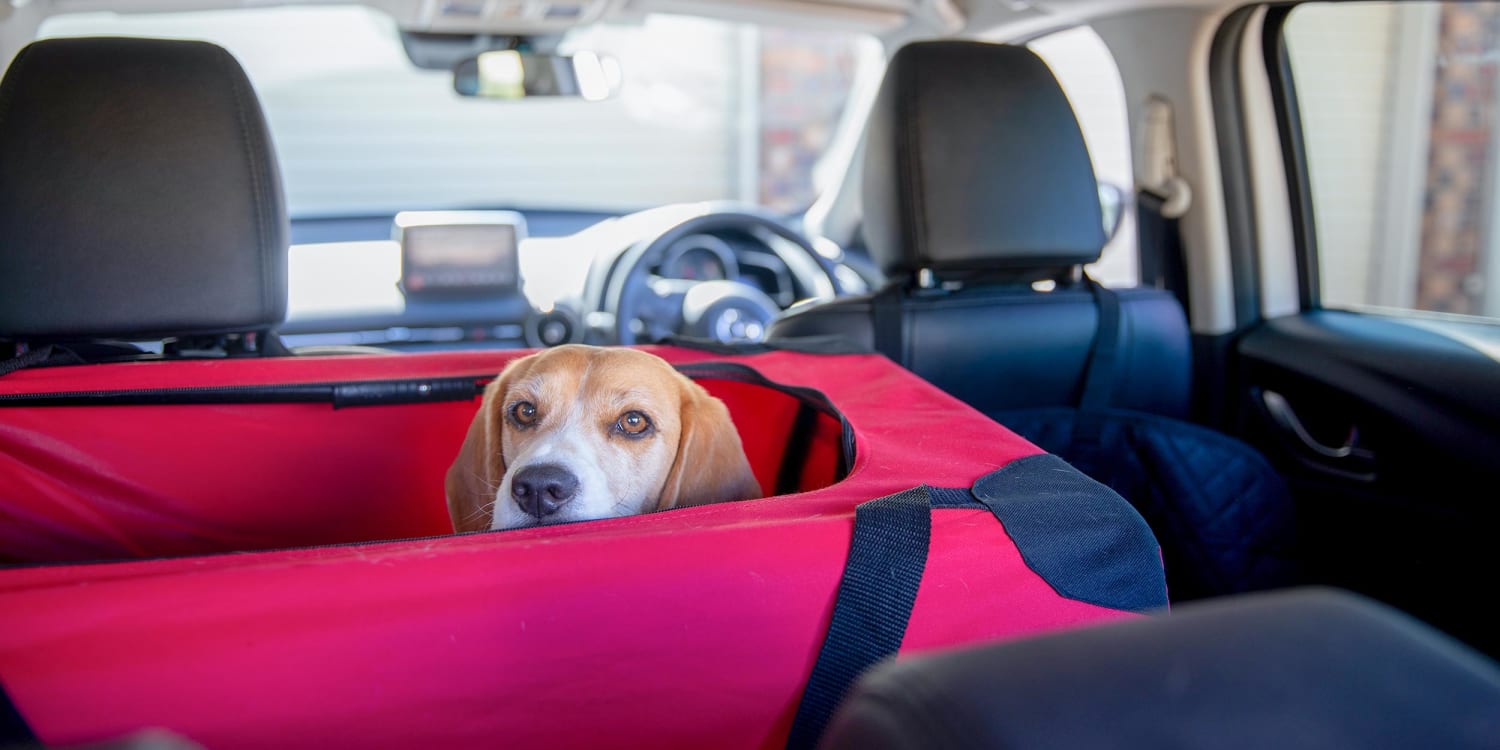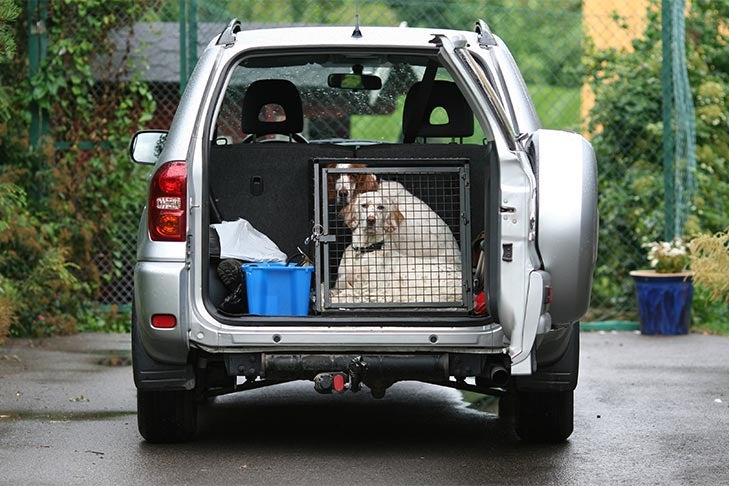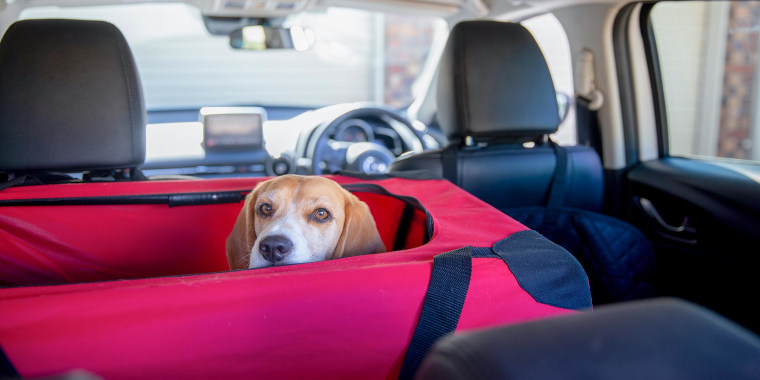To transport a puppy in a car, use a cozy crate or carrier securely fastened in the backseat. Offer regular breaks and never leave the puppy unattended.
Introducing your puppy to car travel can be a nerve-wracking experience for both you and your furry friend. However, with proper planning and execution, transporting your puppy in a car can be safe and stress-free. We will discuss some essential tips on how to transport a puppy in a car to ensure their comfort and well-being throughout the journey.
Whether you’re going on a short trip to the vet or embarking on a longer adventure, these guidelines will help you prepare for a smooth ride. Remember, patience, preparation, and prioritizing your puppy’s safety are key to a successful car journey.

Credit: www.nbcnews.com
1. Preparing For The Journey
When it comes to taking your new puppy on a car journey, proper preparation is key. Taking the time to prepare in advance will help ensure a smooth and comfortable ride for your furry friend. In this section, we will discuss two important steps to consider when preparing for the journey: acclimating your puppy to the car and securing the proper equipment.
1.1 Acclimating Your Puppy To The Car
Before embarking on any car journey with your puppy, it’s essential to first acclimate them to the car environment. Many puppies may feel anxious or fearful when it’s their first time being in a vehicle. Taking small steps to familiarize your puppy with the car will help reduce their stress and make subsequent journeys more enjoyable.
Here are a few tips for acclimating your puppy to the car:
- Start by introducing your puppy to the car while it’s stationary. Park the car in a safe location and let your puppy explore the interior. Allow them to sniff around, get comfortable with the space, and associate it with positive experiences, like treats or toys.
- Gradually progress to short car rides around the block. Start with brief outings and gradually increase the duration as your puppy becomes more comfortable. Pay attention to your puppy’s body language and behavior during the ride.
- Ensure a positive experience by providing a comfortable space for your puppy. Use a soft blanket or dog bed to make their seating area cozy. You can also place familiar toys or a favorite blanket in the car to provide a sense of security.
- Offer rewards and praise to reinforce positive behavior. Reward your puppy for calm and relaxed behavior during car rides. This will help them associate the car with positive experiences and reduce any anxiety or fear they may feel.
1.2 Securing The Proper Equipment
Securing the proper equipment is crucial to ensure the safety of both you and your puppy during car journeys. Proper equipment helps prevent accidents, distractions, and potential injuries. Here are a few essentials you should consider:
| Equipment | Description |
|---|---|
| 1. Dog Seat Belt or Harness | A dog seat belt or harness is designed to secure your puppy safely in the car. It prevents them from moving around or jumping onto your lap, minimizing distractions and potential accidents. |
| 2. Dog Carrier or Crate | A dog carrier or crate provides a secure and confined space for your puppy during car rides. It also reduces the risk of injury in case of sudden stops or accidents. Make sure the carrier or crate is appropriately sized for your puppy, allowing them to stand, sit, and lie down comfortably. |
| 3. Window Shades | Window shades help block out excessive sunlight and minimize heat inside the car. This keeps your puppy comfortable and prevents them from getting overheated. |
| 4. Non-Slip Mats | Non-slip mats provide traction and prevent your puppy from sliding around on smooth car surfaces. This adds an extra layer of security and reduces their anxiety during the journey. |
By ensuring you have the proper equipment, you can provide a safe and comfortable journey for your puppy. Remember to always secure your puppy appropriately and follow any local laws or regulations regarding pet transportation in vehicles.
:max_bytes(150000):strip_icc()/dog-on-plane-1065666556-2000-5951fb006f47490ea64a7c252fcfcf89.jpg)
Credit: www.dailypaws.com
2. Ensuring A Comfortable And Safe Ride
When it comes to transporting your puppy in a car, ensuring their comfort and safety is of utmost importance. A comfortable and safe ride will not only keep your puppy calm and relaxed but also provide peace of mind for you as a pet owner. In this section, we will discuss two key factors to achieve a comfortable and safe ride with your puppy: choosing the right carriers or crates and properly securing the carrier in the car.
2.1 Choosing The Right Carriers Or Crates
Choosing the right carrier or crate is essential to provide a secure and cozy space for your puppy during the car ride. Consider the following factors to make an informed decision:
- Size: Select a carrier or crate that allows your puppy to stand, sit, lie down, and turn around comfortably. It should not be too spacious to prevent your puppy from being thrown around during sudden movements.
- Material: Opt for carriers or crates made of sturdy and durable materials such as hard plastic or metal. This will provide better protection in case of any accidents or impacts.
- Ventilation: Ensure the carrier or crate has proper ventilation to keep the air circulation optimal and prevent your puppy from getting overheated or suffocated.
- Accessibility: Look for carriers or crates with easy access points such as secure doors or zippers. This will allow you to check on your puppy and provide necessary comfort or care during the journey.
2.2 Properly Securing The Carrier In The Car
Properly securing the carrier in the car is crucial to prevent any accidents or injuries caused by your puppy’s carrier sliding or tipping over. Follow these steps to ensure a safe and stable setup:
- Seat Placement: Choose a suitable location for the carrier, such as the back seat or the cargo area of an SUV. This will minimize your puppy’s exposure to airbags and enhance their overall safety.
- Seatbelt or Straps: Utilize a seatbelt or straps specifically designed for securing carriers or crates in the car. Attach the seatbelt or straps to the carrier’s designated anchor points, ensuring a tight and stable connection.
- Anti-Slip Mat: Place an anti-slip mat or a towel underneath the carrier to prevent it from sliding around while the car is in motion. This extra layer of security will ensure a smooth and stable ride for your puppy.
- Avoid High Platforms: Refrain from placing the carrier on high platforms like the car’s roof or trunk. These areas pose a higher risk for your puppy’s safety due to increased movement and exposure to external elements. Stick to the recommended seating areas mentioned earlier.
By following these guidelines for choosing the right carrier or crate and properly securing it in the car, you can ensure a comfortable and safe ride for your furry friend. Implementing these measures will not only protect your puppy from potential harm but also give you peace of mind throughout the journey.
3. Minimizing Stress And Anxiety
Transporting your puppy in a car can be stressful, but there are ways to minimize the anxiety. Follow these tips to ensure a smooth and comfortable journey for your furry friend.
Transporting your puppy in a car can be a stressful experience for both you and your furry friend. To ensure a smooth and anxiety-free journey, it’s crucial to take steps to minimize stress and create a calm environment. Here are two essential practices to follow:3.1 Familiarizing Your Puppy With The Car
Before embarking on your journey, it’s important to familiarize your puppy with the car. This will help them feel more secure and comfortable during the ride. Here are a few steps you can take to achieve this:- Start by introducing your puppy to the car while it’s stationary. Allow them to sniff around and explore the interior. This will help them become familiar with the sights, sounds, and smells of the car.
- Next, gradually progress to short trips around the neighborhood, gradually increasing the duration of each trip. This will help your puppy adjust to the motion and vibrations of the car, reducing the likelihood of motion sickness.
- During these initial trips, reward your puppy with treats and praise for their calm behavior. This positive reinforcement will associate the car with positive experiences, helping your puppy form a positive association with car travel.
3.2 Keeping The Environment Calm
Creating a calm and soothing environment inside the car is essential to minimize stress and anxiety. Here are a few ways to achieve this:- Ensure the temperature inside the car is comfortable for your puppy. Avoid extremes of heat or cold, and use appropriate ventilation or air conditioning as needed.
- Use familiar bedding or blankets in the car to provide a sense of comfort and security for your puppy. The familiar scent will help them relax during the journey.
- Avoid loud music or sudden noises that can startle your puppy. Opt for calming music or white noise to create a peaceful atmosphere.
- Consider using a crate or a pet carrier that your puppy is familiar with. This confined space can offer a sense of security during the car ride.
- If possible, have a familiar person sit with your puppy in the backseat during the journey. The presence of a trusted companion can help ease anxiety and provide reassurance.
- Plan for regular breaks during long car rides to allow your puppy to stretch their legs, relieve themselves, and have a drink of water. This will help prevent restlessness and discomfort.

Credit: www.akc.org
4. Planning For Pit Stops
When it comes to transporting a puppy in your car, taking regular pit stops is crucial. These breaks serve multiple purposes, ensuring your puppy’s comfort and well-being throughout the journey. Here are some essential factors to consider during these pit stops.
4.1 Scheduling Regular Breaks
Scheduling regular breaks allows your puppy to stretch their legs, relieve themselves, and avoid potential discomfort or anxiety during long car rides. It is recommended to plan for a pit stop every two to three hours, depending on the puppy’s age, energy level, and their bladder control. Keep in mind that puppies have smaller bladders and may need more frequent stops compared to adult dogs.
During these breaks, choose safe and clean areas where your puppy can freely roam and explore without any potential hazards. Avoid crowded places or unfamiliar environments that may overwhelm your puppy, leading to stress or anxiety.
4.2 Providing Necessary Supplies
To ensure a smooth and comfortable pit stop experience, it’s important to provide your puppy with the necessary supplies. These supplies will help you manage any accidents, keep the puppy hydrated, and maintain their general well-being throughout the journey.
Here are some essential supplies to include:
- Leash: Always have a leash readily available to secure your puppy during pit stops. This prevents them from wandering off or getting into any potentially dangerous situations.
- Water and Bowl: Carry a portable water bottle and a collapsible bowl to keep your puppy hydrated. Offer them water during the pit stops to prevent dehydration, especially during hot or humid weather.
- Puppy Pads or Absorbent Towels: Accidents may happen, so be prepared by carrying puppy pads or absorbent towels. These will help manage any urine or feces accidents and maintain a clean environment for both you and your puppy.
- Treats and Favorite Toys: Bringing along treats and your puppy’s favorite toys can provide comfort and distraction during the pit stops. These familiar items help alleviate anxiety and make the breaks more enjoyable for your puppy.
By scheduling regular breaks and providing necessary supplies, you can ensure a smoother and stress-free car journey for both you and your puppy. Taking these precautions will also help establish positive associations with car rides, making future travel experiences more pleasant and enjoyable.
5. Handling Emergencies And Unforeseen Situations
When traveling with your puppy in a car, it is essential to be prepared for emergencies and unforeseen situations. Taking proactive measures can help ensure your puppy’s safety and well-being throughout the journey. This section will cover two crucial aspects of handling emergencies: knowing basic first aid for puppies and having emergency contacts and supplies readily available.
5.1 Knowing Basic First Aid For Puppies
Accidents can happen at any time, and being equipped with basic first aid knowledge can make a significant difference in your puppy’s outcome. Here are some key points to remember when administering first aid:
- Stay calm and assess the situation: When faced with an emergency, it’s important to remain composed to provide proper care for your puppy.
- Address any bleeding: If your puppy experiences a cut or bleeding, apply gentle pressure using a clean cloth or bandage to control the bleeding.
- Treating wounds: Clean the wound with an antiseptic solution and apply a sterile dressing to minimize the risk of infection.
- Dealing with fractures: If you suspect a fracture, immobilize the affected limb by gently splinting it, ensuring that your puppy is comfortable and stable until you can seek veterinary assistance.
- Recognizing signs of distress: Familiarize yourself with common signs of distress in puppies, such as difficulty breathing, pale gums, or seizures, and take appropriate action based on the severity of the situation.
Remember, first aid is a temporary measure, and it’s crucial to seek professional veterinary care as soon as possible to ensure proper treatment and recovery for your furry friend. Keep the contact information of a trusted veterinarian handy in case of emergencies.
5.2 Having Emergency Contacts And Supplies Ready
Being prepared for emergencies involves having essential contacts and supplies easily accessible during your puppy’s car journey. Here’s what you need to do:
- Collect emergency contact numbers: Compile a list of emergency contacts, including your regular veterinarian, an after-hours veterinary clinic, and a local animal poison control center.
- Pack a first aid kit: Assemble a well-stocked first aid kit specifically for your puppy. Items that should be included are gauze, adhesive tape, non-stick bandages, antiseptic solution, tweezers, and a digital thermometer.
- Include puppy essentials: Bring along items like extra food, water, collapsible bowls, blankets, and sturdy leashes in case of car breakdowns or unexpected delays.
Keep these emergency contacts and supplies together in a designated bag or container within easy reach in your car. Being prepared will help you to act swiftly in case of an emergency, ensuring the safety and comfort of your puppy.
Frequently Asked Questions On How To Transport Puppy In Car
How Do You Transport A Puppy For The First Time In A Car?
To transport a puppy for the first time in a car, place them in a secure crate or carrier to ensure their safety. Make sure to prepare the car with soft bedding and keep the temperature comfortable. Take breaks for bathroom breaks and stretch their legs, and offer them water and treats as needed.
How Do I Bring My 8 Week Old Puppy Home In The Car?
To safely bring your 8-week-old puppy home in the car, use a secure crate or carrier. Gradually acclimate your puppy to the car by taking short trips, offering treats and positive reinforcement. Use a harness or leash for added security.
Ensure proper ventilation and avoid leaving your puppy alone in the car.
How Do You Travel With A New Puppy In A Car?
Traveling with a new puppy in a car requires planning. Ensure safety by using a secure carrier or crate. Bring food, water, toys, and blankets for comfort. Stop frequently for bathroom breaks and short walks. Make sure your puppy is comfortable and secure to have a stress-free journey.
How Do You Transport A Puppy In A Car Without A Crate?
To transport a puppy in a car without a crate, secure them with a dog seat belt harness or use a pet carrier. Ensure the puppy is safe, comfortable, and unable to distract the driver. Regular breaks are essential for restroom breaks, exercise, and keeping the puppy calm during the journey.
How Can I Safely Transport My Puppy In A Car?
To safely transport your puppy in a car, use a well-ventilated crate or harness them properly.
What Are The Best Practices For Traveling With A Puppy In A Car?
When traveling with a puppy in a car, secure them properly, pack essentials, plan for breaks, and keep the environment calm.
Conclusion
Transporting your puppy in a car can be an exciting but daunting experience. By following these simple steps, you can ensure a safe and comfortable journey for your furry friend. Remember to use a secure crate, provide plenty of breaks for exercise and bathroom breaks, and never leave your puppy alone in a parked car.
With a little preparation and care, you and your puppy can enjoy many adventures together on the road. Happy travels!

